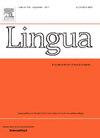Deciphering cross-genre dynamics: Testing the Law of Abbreviation and the Meaning-Frequency Law in Chinese across genres
IF 1.3
3区 文学
0 LANGUAGE & LINGUISTICS
引用次数: 0
Abstract
The study examined the applicability of two linguistic laws, i.e., the Law of Abbreviation and the Meaning-Frequency Law, in Chinese across four text genres. Linear mixed-effects models were employed to explore the genre-mediated effects on the two laws. The results confirmed the validity of both laws at the character level in Chinese while also demonstrating significant genre-specific variations. The effect of genre on the relationships among character length, polysemy, and frequency was particularly pronounced in less formal genres. Additionally, across all genres, character polysemy consistently exhibited a stronger effect on character frequency than character length. The results were discussed from several perspectives, including the underlying mechanisms of the two laws (i.e., the principle of least effort and the lexical synergetic system theory), trade-offs between communication accuracy versus efficiency across genres, and the differing impacts on communication costs of character polysemy and character length. Implications of the study are also discussed for researchers interested in Zipfian laws across languages.
解读跨体裁动态:跨体裁汉语缩略语规律和意义频次规律的检验
本研究考察了汉语缩略语规律和意义频次规律在四种文本体裁中的适用性。采用线性混合效应模型探讨类型对这两个定律的中介效应。结果证实了这两个规律在汉字水平上的有效性,同时也显示出显著的体裁差异。体裁对字符长度、多义词和频率之间的关系的影响在不太正式的体裁中尤为明显。此外,在所有体裁中,字符多义性对字符频率的影响始终强于字符长度。研究结果从两个方面进行了讨论,包括两个规律的潜在机制(即最省力原则和词汇协同系统理论),跨体裁的传播准确性与效率的权衡,以及汉字多义性和字符长度对传播成本的不同影响。本研究的意义也讨论了研究人员感兴趣的齐普法跨语言。
本文章由计算机程序翻译,如有差异,请以英文原文为准。
求助全文
约1分钟内获得全文
求助全文
来源期刊

Lingua
Multiple-
CiteScore
2.50
自引率
9.10%
发文量
93
审稿时长
24 weeks
期刊介绍:
Lingua publishes papers of any length, if justified, as well as review articles surveying developments in the various fields of linguistics, and occasional discussions. A considerable number of pages in each issue are devoted to critical book reviews. Lingua also publishes Lingua Franca articles consisting of provocative exchanges expressing strong opinions on central topics in linguistics; The Decade In articles which are educational articles offering the nonspecialist linguist an overview of a given area of study; and Taking up the Gauntlet special issues composed of a set number of papers examining one set of data and exploring whose theory offers the most insight with a minimal set of assumptions and a maximum of arguments.
 求助内容:
求助内容: 应助结果提醒方式:
应助结果提醒方式:


